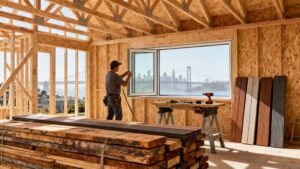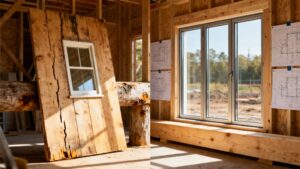Embarking on a home renovation in the San Francisco Bay Area is an exciting venture, but it is also a complex undertaking with unique regional challenges. Navigating Berkeley's specific building codes or sourcing materials that withstand our coastal climate requires careful planning. A successful project is the result of meticulous foresight, and this definitive home renovation checklist provides a structured, phase-by-phase framework for contractors, architects, and homeowners.
This guide moves beyond generic advice to offer actionable strategies tailored to our local environment. We will cover 10 critical steps essential for keeping your project on schedule and within budget. You will find practical insights on everything from securing the right permits in Oakland to selecting durable, high-performance materials suitable for Bay Area weather.
Think of this checklist as your strategic roadmap to anticipate challenges and make informed decisions. Whether you are executing a full-scale build or a modern kitchen upgrade, following these steps will help you manage the process with confidence. Let's build it right, from the ground up.
Phase 1: Set a Realistic Budget and Add a 20% Bay Area Contingency
A meticulously planned budget is the foundation of any successful home renovation checklist, especially in the high-cost Bay Area market. It requires a detailed breakdown of all anticipated expenses, including materials, labor, permits, and disposal fees. A well-structured budget acts as your project’s financial roadmap, preventing costly overruns.

Why a Bay Area Contingency is Non-Negotiable
In regions like Berkeley, Oakland, and San Francisco, we recommend allocating a 20% contingency fund. Older homes in the East Bay frequently hide issues like dry rot, outdated electrical systems, or the need for seismic retrofitting, often discovered after demolition. According to the U.S. Census Bureau, many homes in the Bay Area were built before modern codes, making such discoveries common.
For instance, a Berkeley kitchen renovation with a base budget of $80,000 should have an additional $16,000 set aside. This fund ensures that if a structural engineer requires an unexpected shear wall, the project proceeds without derailing your finances.
Actionable Budgeting Tips for Bay Area Projects
- Gather Multiple Bids: Obtain at least three detailed quotes from licensed Bay Area contractors. Ensure each bid itemizes costs for labor, materials from a reputable Berkeley building materials supplier, and permits.
- Price Materials Accurately: Visit local showrooms like Truitt & White in Berkeley to get current pricing on key components like premium windows, doors, and lumber.
- Track Every Dollar: Use a shared spreadsheet or project management software to log every expense in real-time, creating transparency for the entire team.
- Factor in Green Building Costs: Many Bay Area municipalities have strict green building codes. According to the California Energy Commission, these standards often require materials or systems that may impact your budget.
Phase 2: Obtain Necessary Permits and Approvals
Securing the correct permits is a critical, non-negotiable step in any legitimate home renovation checklist. This ensures your project complies with local Berkeley, Oakland, or greater Bay Area building codes. Proper permits guarantee that all work meets stringent safety standards, which is essential for preserving property value.
Why Early Permit Application is Crucial in the Bay Area
Navigating the permitting process in Bay Area municipalities can be notoriously slow and complex. Starting this process as early as possible prevents it from becoming a bottleneck. For example, a bathroom addition in Oakland requires a combination of building, plumbing, and electrical permits.
Submitting detailed plans early allows the building department to review for compliance with Title 24 energy codes and local structural requirements. This avoids last-minute redesigns that would delay the start of construction and frustrate your clients.
Actionable Permitting Tips for Bay Area Renovators
- Consult the Local Building Department First: Before finalizing designs, contact your city's planning and building department to understand their submission requirements and timelines.
- Prepare Comprehensive Plans: Your permit application must include detailed architectural and structural plans. Vague or incomplete drawings are a primary cause of rejection.
- Schedule Inspections Strategically: As soon as your permit is issued, map out the required inspection milestones (e.g., foundation, framing, final). Schedule these appointments well in advance.
- Keep All Documentation On-Site: A physical copy of the approved permit and plans must be readily accessible at the job site at all times to avoid work stoppages.
Phase 3: Create a Detailed Timeline with Milestones
A well-structured timeline is the operational backbone of your home renovation checklist. It coordinates every critical stage, from demolition and material deliveries to inspections and final touches. By establishing clear milestones, you can effectively schedule contractors and account for potential delays common in Bay Area projects.

Caption: A sample timeline illustrating key phases of a home renovation: Demolition, Rough-in/Inspections, and Finishing.
Why a Milestone-Driven Schedule is Essential
Simply listing tasks is not enough; a successful timeline identifies key milestones that mark the completion of a major phase. For instance, passing the framing inspection must occur before insulation and drywall can begin. This approach is a hallmark of an efficient construction process in the Bay Area.
A 12-week kitchen renovation might set a milestone for "Cabinet Installation Complete" by week 8. This signals the countertop fabricator to perform the final measurement, preventing delays.
Actionable Timeline Tips for On-Time Completion
- Build in Buffer Time: Always add a 10-15% time buffer to your schedule to account for unexpected delays like a failed inspection or material backorders.
- Use Project Management Tools: Utilize apps like Trello or Asana to create a shared timeline, keeping the client, contractor, and subcontractors aligned.
- Confirm Material Lead Times: Before finalizing your schedule, confirm lead times for items like custom Bay Area windows and doors. Order them early.
- Plan for Inspections: Research your local building department’s inspection schedule. Some cities in Alameda or Contra Costa counties may require several days' notice.
Phase 4: Hire Licensed and Insured Contractors
Selecting the right professional is one of the most critical steps in any home renovation checklist. Licensed contractors have demonstrated competency, while adequate insurance protects you from liability. This phase requires diligent vetting to safeguard your investment.

Why Vetting is Essential for Bay Area Projects
In the Bay Area, where projects often involve complex seismic codes, hiring an unlicensed individual is a significant risk. A licensed general contractor is responsible for coordinating all aspects of the job. Forgoing this step can lead to failed inspections and work that must be completely redone.
For example, any structural modification in a Berkeley or Oakland home demands a contractor who understands local engineering requirements. An unvetted contractor might overlook the need for specific shear wall reinforcements, jeopardizing safety.
Actionable Vetting Tips for Finding the Right Pro
- Verify Licenses and Insurance: Always check the contractor's license status on the California Contractors State License Board (CSLB) website. Ask for copies of their insurance certificates.
- Conduct Thorough Due Diligence: Go beyond online reviews. Using an effective due diligence checklist template can help organize your questions and cover all critical areas.
- Check References and Past Work: Ask for a list of recent, local projects and contact the homeowners to ask about their experience.
- Demand a Detailed Written Contract: A professional contract should clearly outline the scope of work, a payment schedule, material specifications, and a project timeline.
Phase 5: Plan for Temporary Living Arrangements
A major renovation often makes a home temporarily uninhabitable, especially in densely populated areas like the Bay Area. Planning for temporary living arrangements is a crucial step in any comprehensive home renovation checklist. This phase involves proactively addressing how daily life will continue amidst the disruption.
Why Pre-Planning Your Living Situation is Critical
Failing to plan for alternative living solutions can lead to immense stress and project delays. An extensive kitchen remodel in an Oakland bungalow or a bathroom overhaul in a Berkeley craftsman home can render essential facilities unusable for weeks. A clear plan prevents a last-minute scramble for housing and gives the project team unimpeded access.
A well-thought-out temporary living strategy protects the family's well-being and the project’s momentum. This decision directly impacts the project’s efficiency and the client’s sanity.
Actionable Tips for Managing Disruption
- Budget for Temporary Housing: If a full move-out is necessary, factor the cost of a short-term rental into your initial project budget.
- Create a Temporary Kitchen: For kitchen remodels, set up a functional temporary kitchen in another area with a microwave, a hot plate, and a mini-fridge.
- Pack and Protect Belongings: Carefully pack non-essential items and move furniture away from the construction zone. Use plastic sheeting to protect anything left behind from dust.
- Establish Clear Communication: Work with your contractor to define work hours, access points, and "no-go" zones to minimize conflicts.
Phase 6: Establish Clear Communication Channels
Seamless and transparent communication is the lifeblood of a successful home renovation. Establishing clear protocols for updates, decisions, and issue resolution ensures that homeowners, contractors, and designers remain aligned. This structured approach transforms potential chaos into a coordinated effort.
Why Consistent Communication Protocols Are Critical
In a fast-paced renovation, informal chats can lead to forgotten details. A formalized communication strategy ensures every decision is documented. A comprehensive project communications plan centralizes information and clarifies expectations.
For example, a homeowner might verbally approve a change to a tile layout. Without a written record, the installer may proceed with the original plan, leading to expensive errors.
Actionable Communication Tips for Project Success
- Schedule Regular Check-Ins: Institute mandatory weekly on-site meetings or video calls to review progress and discuss upcoming tasks.
- Define Preferred Methods: Agree on primary communication tools from the start. Use a project management app for major decisions and email for formal documentation.
- Document Everything: Keep a running log of all decisions, change orders, and material selections in a shared cloud folder.
- Use Visual Updates: Require daily or bi-weekly photo updates from the job site to give homeowners a clear sense of progress, especially if they are not living on-site. This level of service is a key part of customer service excellence for professional builders.
Phase 7: Secure Materials and Finishes Early
Securing materials and finishes well in advance is a cornerstone of an effective home renovation checklist. This step involves researching lead times, coordinating delivery logistics, and ensuring proper on-site storage. Proactive material procurement mitigates the risk of delays and budget overruns.
Caption: A contractor selects quality lumber from a well-stocked lumberyard, an essential step in securing materials early.
Why Early Ordering Is a Project-Saver in the Bay Area
In the Bay Area construction market, waiting to order key components is a recipe for disaster. Custom items like high-performance windows, cabinetry, and specialty tile can have lead times of 8 to 16 weeks or more. According to the National Association of Home Builders (NAHB), supply chain disruptions continue to be a challenge for the industry.
For example, if your Oakland home addition requires specific Marvin windows, ordering them only when the framing is complete could halt progress for months. Ordering from a trusted lumberyard near Oakland during the design phase ensures materials arrive on time.
Actionable Material Procurement Tips
- Create a Master Materials List: Compile a comprehensive list of all required materials, from framing lumber to cabinet pulls, with your architect and contractor.
- Confirm Lead Times Immediately: Contact suppliers for current lead times for every item. Do not rely on old data.
- Inspect All Deliveries: Upon arrival, immediately unbox and inspect all materials for damage or discrepancies.
- Plan for Proper Storage: Ensure you have a secure, climate-controlled space to store materials like hardwood flooring, cabinetry, and doors to prevent damage.
Phase 8: Address Structural and Safety Issues First
Prioritizing structural integrity and safety is a non-negotiable step in any serious home renovation checklist. This phase focuses on the "bones" of the house, ensuring a stable foundation before any cosmetic work begins. Addressing foundational cracks or outdated electrical systems first prevents catastrophic failures.
Why Safety and Structure Outrank Aesthetics
In the Bay Area, where many homes have weathered decades of seismic activity and coastal moisture, ignoring underlying issues is dangerous. Problems like dry rot, unreinforced masonry, or faulty wiring are often hidden behind walls. Tackling these issues upfront is essential for the longevity of the home.
For example, installing a high-end kitchen on a floor with compromised joists is not only wasteful but unsafe. A licensed structural engineer can identify these critical needs. Utilizing advanced clash detection and coordination services can proactively identify conflicts between structural components and new systems, preventing costly on-site fixes.
Actionable Tips for Prioritizing Critical Repairs
- Hire Specialized Inspectors: Engage licensed structural engineers, electricians, and plumbers to assess critical systems. Their expert reports provide a clear, prioritized repair list.
- Upgrade Key Systems First: Before a major remodel, confirm the electrical panel can handle new appliance loads and that main plumbing lines are free of corrosion.
- Budget for the Unseen: Always allocate a significant portion of your contingency fund specifically for structural and safety repairs.
- Document All Repairs for Compliance: Keep detailed records of all structural and safety work, including permits and inspection approvals, for future sales and code compliance.
Phase 9: Plan for Waste Management and Disposal
A well-organized waste management strategy is a non-negotiable component of any professional home renovation checklist. This crucial step ensures environmental compliance and maintains a safe, efficient job site. Proper planning involves arranging for dumpster rentals and implementing recycling programs.
Why Proactive Waste Planning is Essential in the Bay Area
In environmentally conscious regions like Berkeley and Oakland, many municipalities enforce strict construction and demolition (C&D) debris recycling ordinances. Failing to properly sort materials like wood, metal, and concrete can lead to significant fines. This makes waste planning a critical sustainability priority.
A complete kitchen gut in an older Oakland home can generate several tons of mixed debris. This may include old cabinetry, drywall, and potentially hazardous materials that require a certified abatement professional.
Actionable Waste Management Tips for Bay Area Projects
- Size Your Dumpster Correctly: Assess the project scope to choose the right dumpster, from a 10-yard for a small bathroom to a 30-yard for a major addition.
- Research Local Regulations: Before demolition begins, consult your city’s website (e.g., City of Berkeley) to understand specific C&D recycling requirements and diversion percentages.
- Schedule Pickups in Advance: Coordinate with your waste management provider to schedule dumpster drop-offs and pickups to avoid overflowing containers.
- Implement On-Site Sorting: Set up designated areas for different materials like clean wood, metal, and cardboard to streamline recycling and meet local mandates.
Phase 10: Conduct Regular Quality Inspections
Systematic quality control is a critical component of any home renovation checklist. This phase involves scheduled inspections at key milestones to identify potential issues early. A proactive quality assurance process protects the project's integrity, budget, and timeline.
Caption: A contractor and homeowner review blueprints during a framing inspection, a key quality control step.
Why Proactive Inspections Are Essential
Waiting until the end of a project to find mistakes leads to budget overruns and delays. Regular inspections allow for immediate course correction. For instance, discovering an incorrectly framed window before drywall is installed is a relatively simple fix.
In the Bay Area, where projects often involve complex seismic upgrades, ongoing verification is even more crucial. Consistent checks ensure every stage of construction complies with approved plans and local codes.
Actionable Quality Control Tips for Flawless Execution
- Create Detailed Inspection Checklists: Develop checklists for each phase of the project (e.g., framing, plumbing rough-in) that reference architectural plans.
- Document Everything with Photos: Conduct daily walk-throughs and take timestamped photos of the progress. This visual record is invaluable for resolving disputes.
- Address Issues Immediately: When an issue is identified, document it and communicate with the responsible trade partner right away.
- Hire Independent Inspectors for Major Milestones: For critical stages like foundation or structural framing, consider hiring a third-party inspector for an extra layer of assurance.
Frequently Asked Questions (FAQ)
1. What is a realistic contingency fund for a Bay Area renovation?
We strongly recommend a contingency fund of at least 20% of your total budget for Bay Area projects. The region's older housing stock often hides unforeseen issues like dry rot, outdated wiring, or the need for seismic retrofitting, which can significantly impact costs.
2. How long does it take to get a building permit in Oakland or Berkeley?
Permit timelines can vary widely, from a few weeks for simple projects to several months for complex additions or new construction. It depends on the city's workload and the project's complexity, which is why we advise starting the application process as early as possible.
3. What are the benefits of using energy-efficient windows in the Bay Area?
Energy-efficient windows, like those meeting ENERGY STAR® or California's Title 24 standards, provide significant benefits. They reduce heating and cooling costs, improve indoor comfort by minimizing drafts, and can increase your home's resale value.
4. Why is it important to use a local building materials supplier?
A local supplier like Truitt & White understands the specific challenges of Bay Area construction, from our coastal climate to local building codes. They can provide expert advice on the right materials, such as moisture-resistant lumber or high-performance windows, and often have more reliable local stock and delivery logistics.
5. Do I need a licensed contractor for small renovation jobs?
In California, any project valued at $500 or more (including labor and materials) legally requires a licensed contractor. Using a licensed professional ensures the work meets safety standards, is insured, and protects you from liability.
Your Renovation Partner in the Bay Area
A meticulously planned project is the bedrock of a successful renovation. By systematically working through this home renovation checklist, you transform a chaotic process into a structured, rewarding journey. This checklist is a strategic framework designed to empower you, whether you're a seasoned Bay Area contractor, an innovative architect, or a homeowner.
By following this guide, you can ensure your project finishes on schedule, within budget, and to the highest standards of quality. A successful renovation enhances not just a property’s value but the quality of life for those who inhabit the space. You are now equipped to manage your next Bay Area project with confidence and precision.
For nearly 80 years, Truitt and White has been the Bay Area's trusted partner for every item on your home renovation checklist, from foundational lumber to exquisite finishing materials. Our team provides the expert guidance and premium products, including Marvin windows and doors, needed to navigate local codes and bring your architectural vision to life. Visit our Berkeley showroom for expert advice.









